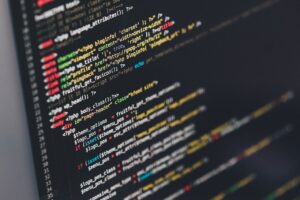Introduction
In today’s digital age, computer programming has become an essential skill. From creating simple websites to developing complex algorithms for artificial intelligence, programming is the backbone of the technology that powers our world. This article explores the fascinating realm of computer programming, delving into its history, significance, various programming languages, and future trends.
Early Developments
- 1940s-1950s: The development of early computers like the ENIAC and UNIVAC marked the beginning of electronic computing. Assembly language was one of the first programming languages, providing a low-level way to communicate with these machines.
- 1950s-1960s: The invention of high-level programming languages like FORTRAN, COBOL, and LISP revolutionized computer programming, making it more accessible and versatile.
The Rise of Modern Programming Languages
- 1970s-1980s: Languages such as C and Pascal became popular, offering structured programming paradigms. Object-oriented programming (OOP) emerged with languages like Smalltalk and later, C++.
- 1990s-2000s: The internet boom led to the creation of web-centric languages like JavaScript, PHP, and Java. Python and Ruby also gained traction for their simplicity and power.
The Significance of Computer Programming
Computer programming is more than just writing code. It is a way of thinking, problem-solving, and creating solutions that impact every aspect of modern life.
Driving Technological Innovation
Programming drives innovation across various fields:
- Healthcare: From electronic health records to telemedicine, programming enables advancements that improve patient care and medical research.
- Finance: Algorithms in trading, fraud detection, and risk management are made possible through programming.
- Entertainment: Video games, movies, and music rely heavily on programming for development and distribution.
Enhancing Productivity and Efficiency
Automation through programming increases productivity and efficiency in many industries. Tasks that once took hours can now be completed in seconds, thanks to scripts and software programs.
Creating New Opportunities
The demand for skilled programmers continues to rise, opening up numerous career opportunities. From software development to data science, programming skills are highly sought after.
Popular Programming Languages
There are hundreds of programming languages, each with its unique strengths and use cases. Here are some of the most popular ones:
Python
Python is known for its simplicity and readability, making it an excellent choice for beginners. It is widely used in web development, data science, artificial intelligence, and automation.
JavaScript
JavaScript is the backbone of web development, enabling interactive and dynamic web pages. With frameworks like React and Angular, JavaScript has become indispensable for front-end development.
Java
Java is a versatile language used in web development, mobile applications (Android), and enterprise-level applications. Its portability and performance make it a popular choice for large-scale systems.
C++
C++ is a powerful language often used in system software, game development, and applications requiring high performance. It combines the efficiency of C with object-oriented features.
Ruby
Ruby is known for its elegant syntax and is commonly used in web development through the Ruby on Rails framework. It maintain simplicity and productivity.
The Future of Computer Programming
The field of computer programming is constantly evolving. Here are some trends that are shaping its future:
Artificial Intelligence and Machine Learning
AI and machine learning are transforming industries by enabling systems to learn and adapt. Programming languages like Python and R are widely used for developing AI applications.
Quantum Computing
Quantum computing promises to solve problems that are currently unsolvable with classical computers. New programming languages and paradigms are being developed to harness the power of quantum processors.
Low-Code and No-Code Platforms
These platforms allow users to create applications with minimal coding, democratizing software development and enabling non-programmers to build solutions.
Cybersecurity
As cyber threats become more sophisticated, the demand for secure coding practices and cybersecurity professionals is on the rise. Programming plays a crucial role in developing and implementing security measures.
Learning Computer Programming
Learning computer programming can be a rewarding journey. Here are some tips for beginners:
Start with the Basics
Begin with an easy-to-learn language like Python. Focus on understanding fundamental concepts like variables, loops, and functions.
Practice Regularly
Consistent practice is key to mastering programming. Work on small projects, solve coding challenges, and contribute to open-source projects.
Utilize Online Resources
There are numerous online resources available, including tutorials, courses, and coding platforms. Websites like Codecademy, Coursera, and freeCodeCamp offer excellent learning materials.
Join a Community
Joining a programming community can provide support, inspiration, and networking opportunities. Participate in forums, attend meetups, and collaborate with other learners.
Conclusion
Computer programming is a dynamic and ever-evolving field that shapes our digital world. Whether you are a beginner or an experienced coder, there is always something new to learn and explore. Embrace the challenge, stay curious, and continue to hone your skills in this fascinating domain.
By integrating the keyword “computer programming” multiple times throughout the article, we ensure that the content is SEO-friendly while providing valuable information to readers.
